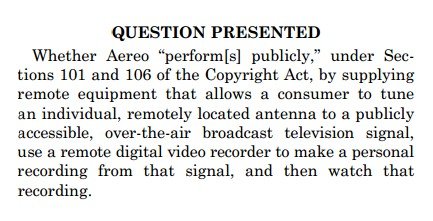It looks like our communications regulatory framework needs to be updated. There were many issues when satellite was barred from re-transmitting local OTA programming, this was not resolved in the courts but by changing the law.
Funny, as a society we criticize TV programming and portray it in a most negative way, but then get angry when even the slightest barriers affect our access.
Not a slight barrier. If the decision went the other way, this could have accelerated cord-cutting. The broadcast networks threatened to stop over the air broadcasting.
Every couple of years, the networks have some kind of impasse when its time to renegotiate retransmission fees with a big cable system or satellite TV. So for a couple of weeks, they warn that such and such a system could lose ABC or CBS. They air out this possibility in public to pressure both sides.
And it's usually the threat of losing a big event, like the NFL playoffs or the start of a new season of some popular show, that finally leads to an agreement. The content companies are always raising fees and the cable and satellite cos are trying to get the lowest prices.
But you know in the end, we always get price increases on our bills.
As for streaming away from the home, that's something they negotiate too. For instance, Comcast can stream certain channels on iPads but not all. They can do the same for some On Demand content, but not all. It's all a matter of how much money changed hands.
Same thing with stuff like WatchESPN, HBO Go, etc.
Me, I just use my Vulkano, which is a cheaper Sling box clone and I can use it anywhere in the world whereas the official sanctioned streaming apps. don't work outside the US (though there are ways around it).
Content companies have to also protect foreign rights, their home video business, etc., so they put all these restrictions, in order to monetize the different distribution methods of the same content.
So if you watch some show on TV, you pay. Watch the same show online, you better be paying. Want to watch it again on DVD or Blu Ray, you pay again. Want to watch it while on vacation overseas, you pay again, only if the rights to that particular show and episode has beeb sold.
I remember going on a trip to Sicily right before the season 1 finale of Game of Thrones. I would have to wait to return from vacation to watch it on my DVR. Or I could have downloaded the torrents and watched it during some down time in my vacation. I've paid a lot of money for HBO over the years (subscribed to it for over 10 years straight, even bought some box sets). But they'd have wanted me to wait to watch.

